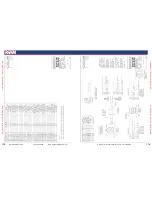
82
Genuine OEM Parts 1.800.233.4823 www.morganolsonparts.com
83
USPS 2 Ton Delivery Vehicle 2016 - 2018 Models
CONFIDENTIAL
NOT
FOR DISTRIBUTION
CONFIDENTIAL
NOT
FOR DISTRIBUTION
CONFIDENTIAL
NOT
FOR DISTRIBUTION
CONFIDENTIAL
NOT
FOR DISTRIBUTION
1.1.1
Verify that transmitter is sending a signal and that transmitter is coded
correctly. See Symptom 3.
1.1
No signal from transmitter
Morgan Olson - 46029040
Trouble Shooting Guide
Sympton 1
No output from one or more outputs on receiver when transmitter buttons are pressed
Possible Cause
Corrective Actions
NST12302-3_A.ai 2015-10-07
Pg -4-
1.2.1
Open receiver and observe yellow LEDs. The yellow output LED should
turn ON as long as relay is ON.
1.2.2
Press each transmitter button in sequence. Using a volt meter, check
each output. there should be a +12v present anytime the corresponding
transmitter button is pressed. If no outputs, call factory for assistance.
1.2
One or more of the outputs have failed
1.3.1
Check wire and equipment for problem.
1.3
Receiver outputs OK, but relays or
equipment do not operate
1.4.1
Check the F2 fuse in fuse block. If it is blown, replace it.
1.4
Fuse is blown
1.5.1
Check dash switch input wire connection on P1 green/yellow wire. If no
voltage, correct wiring.
1.5
Wire harness problem
2.1.1
Check logic ground and logic power +12v. Use a voltmeter probe when
checking voltage.
2.1.2
If either ground or power is not present, locate failure in wire harness
2.1
Logic ground or power connection to
receiver has failed
Sympton 2
Receiver is Dead. Does not operate, no green power LED.
Possible Cause
Corrective Actions
2.2.1
Check chassis ground connection. It should be clean and tight, no paint
on metal, an external tooth star washer should be present, no rust or dirt
in connections.
2.2.2
Chassis ground should be located on vehicle frame or directly to battery.
2.2
Chassis ground connection has failed
2.3.1
Check heart beat LED. If it is not flashing the microprocessor has failed.
Call factory for assistance (in either case).
2.3.2
Check yellow output LEDs. If they DO NOT flash each time correspond-
ing channel is activated, the receiver has failed.
2.3
Receiver and / or microprocessor has
failed
3.1.1
Check antenna placement. It should not be touching any metal or tinted
glass.
3.1.2
It should not be closer than 6’ to any motors or relays / contactors.
3.1.3
If antenna is cut or damaged, call factory for assistance.
Please Note: Antenna can NOT be shortened or altered in any way.
3.1
Antenna damaged or grounded
Morgan Olson - 46029040
Trouble Shooting Guide
Sympton 3
Poor range 0’ to 25’ (pulsating 0’ to 25’)
Possible Cause
Corrective Actions
NST12302-3_A.ai 2015-10-07
Pg -5-
3.2.1
Remove any paint or residue from metal. Using an external tooth star
washer, tighten chassis ground ring terminal securely to vehicle frame.
3.2
Poor ground connection
3.3.1
Replace battery if voltage is 2.8 volts or below.
All transmitters use: Lithium Coin Style - # CR2032
3.3
Transmitter battery low
3.4.1
Electromagnetic interference (EMI) can be generated by motors, welding
equipment, relays, RF from other radio frequency devices, etc. which may
be in close proximity to the receiver or transmitter.
3.4.2
Move closer to antenna or move vehicle out of range of EMI cause by
high levels of RF from devices such as welding equipment, as this is a
temporary problem.
3.4.3
If EMI is cause by relays, door motors or lift motors then the receiver must
be moved or shielded or the EMI noise diverted to ground. Call factory
for detaiils / assistance.
3.4
Interference
3.5.1
Call factory for assistance.
3.5
Receiver component damaged or
defective
3.6.1
Remove all other equipment from logic ground and power. Check range.
If ok, move other antennas, route wires away from the receiver, move
unit away from large motors or run logic power & ground directly from
battery.
3.6
Other equipment installed in vehicle
causing voltage drop when initially
turning on







































